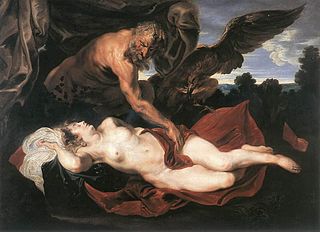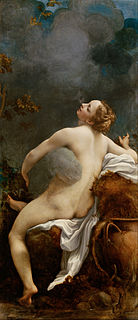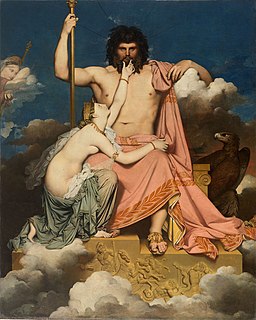 W
WCreation of the World is a mosaic composition in the dome of the Chigi Chapel in Santa Maria del Popolo, Rome, designed by Raphael. The chapel itself was designed by Raphael for his friend and patron, banker Agostino Chigi as a private chapel and family burial place. The dome was decorated with mosaics, a somewhat unusual and old-fashioned technique in the 16th century. Raphael's cartoons were executed by a Venetian craftsman, Luigi da Pace in 1516. The original cartoons were lost but some preparatory drawings, that confirm the originality of the work, survived in the Ashmolean Museum, Oxford. There are two studies for the figure of God and one for the angel above Jupiter. Another drawing in the Palais des Beaux-Arts in Lille shows the planet Mars with an angel. This is probably a creative drawing by a pupil suggested by its inferior quality. Luigi da Pace signed and dated the work at the corner of the panel of Venus:"LV[dovicus] D[e] P[ace] V[enetus] F[ecit] 1516"
 W
WIxion is a 1632 oil painting, signed and dated by Jusepe de Ribera. It shows a scene from Classical mythology, of Ixion being tortured as the eternal punishment meted out by Zeus. It is one of a series of four paintings by Ribera of the four "Furies" or "Condemned" from Greek mythology. It is held by the Museo del Prado in Madrid, along with Ribera's painting of Tityos; the other two, of Sisyphus and Tantalus, are lost.
 W
WJupiter and Antiope is a frequent theme in western painting and has been treated by Titian, Van Dyck, Watteau and David among others.
 W
WJupiter and Antiope is a painting of unknown date, showing Jupiter and Antiope. On the reverse is a sketch of a young woman. It is possibly attributed to Jacques-Louis David, though the attribution is difficult since David disowned most of the works he produced as a young man.
 W
WJupiter and Antiope is a series of two similar oil-on-canvas paintings by the late Baroque Flemish painter Anthony van Dyck. One painting is in the collection of the Museum of Fine Arts, Ghent; the other in the Wallraf-Richartz Museum, Cologne.
 W
WJupiter and Antiope is an oil painting by the French artist Antoine Watteau. It is also known as the Satyr and the Sleeping Nymph and was probably painted between 1714 and 1719. Intended to be placed over a doorway, today it hangs in the Louvre in Paris.
 W
WJupiter and Callisto is a 1744 painting by François Boucher, now in the Pushkin Museum in Moscow. It shows Jupiter disguised as Diana to seduce Callisto.
 W
WJupiter and Callisto or The Nymph Callisto Seduced by Jupiter in the Guise of Diana is a 1759 painting by François Boucher, now in the Nelson-Atkins Museum of Art in Kansas City, USA.
 W
WJupiter and Io is a painting by the Italian High Renaissance artist Antonio da Correggio around 1530. It now hangs in the Kunsthistorisches Museum in Vienna, Austria.
 W
WJupiter et Sémélé is a painting by the French Symbolist artist Gustave Moreau (1826–1898). It depicts a moment from the classical myth of the mortal woman Semele, mother of the god Dionysus, and her lover, Jupiter, the king of the gods. She was treacherously advised by the goddess Juno, Jupiter's wife, to ask him to appear to her in all his divine splendor. He obliged, but, in so doing, brought about her violent death by his divine thunder and lightning. The painting is a representation of "divinized physical love" and the overpowering experience that consumes Semele as the god appears in his supreme beauty which has been called "quite simply the most sumptuous expression imaginable of an orgasm".
 W
WJupiter and Thetis is an 1811 painting by the French neoclassical painter Jean-Auguste-Dominique Ingres, in the Musée Granet, Aix-en-Provence, France. Painted when the artist was yet 31, the work severely and pointedly contrasts the grandeur and might of a cloud-born Olympian male deity against that of a diminutive and half nude nymph. Ingres' subject matter is borrowed from an episode in Homer's Iliad when the sea nymph Thetis begs Jupiter to intervene and guide the fate of her son Achilles; who was at the time embroiled in the Trojan War.
 W
WJupiter Raised by the Nymph Adrasteia or The Childhood of Jupiter is a 17th-century painting by Jacob Jordaens, now in the Gemäldegalerie Alte Meister in Kassel, Germany. It shows the infant Jupiter being raised by the nymph Adrasteia.
 W
WJupiter, Neptune and Pluto is a painting by Italian Baroque master Michelangelo Merisi da Caravaggio. It is located in the Villa Aurora, the former hunting lodge of the erstwhile Villa Ludovisi, Rome. It is unusually painted in oils on plaster and hence it is not a fresco, although it is sometimes (incorrectly) referred to as such. Oil painting is normally on canvas or, less frequently, on wood.
 W
WThe Loves of the Gods is a monumental fresco cycle, completed by the Bolognese artist Annibale Carracci and his studio, in the Farnese Gallery which is located in the west wing of the Palazzo Farnese, now the French Embassy, in Rome. The frescoes were greatly admired at the time, and were later considered to reflect a significant change in painting style away from sixteenth century Mannerism in anticipation of the development of Baroque and Classicism in Rome during the seventeenth century.
 W
WThe Origin of the Milky Way, or The Birth of the Milky Way, is a painting by the Flemish artist Peter Paul Rubens, featuring the Greco-Roman myth of the origin of the Milky Way. The painting depicts Hera (Juno), spilling her breast milk, the infant Heracles (Hercules) and Zeus (Jupiter) in the background, identifiable by his eagle and lightning bolts. Hera's face is modelled on Rubens' wife, Hélène Fourment. The carriage is pulled by Hera's favourite animals, peacocks. Due to the dark background of the night sky the figures gain a greater sense of volume.